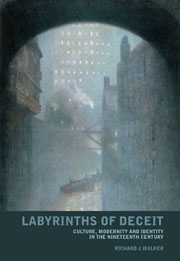Book contents
- Frontmatter
- Contents
- Acknowledgements
- Introduction: Tracing the fragments of modernity
- Part I (De)Generating doubles: duality and the split personality in the prose writing of James Hogg, Robert Louis Stevenson and Oscar Wilde
- Part II The stripping of the halo: religion and identity in the poetry of Alfred Tennyson, James ‘B. V.’ Thomson and Gerard Manley Hopkins
- Introduction
- 4 A life of death: Alfred Tennyson's ‘St Simeon Stylites’
- 5 But what am I? Alfred Tennyson's In Memoriam
- 6 All is vanity and nothingness: James ‘B. V.’ Thomson's haunted city
- 7 Dead letters: Gerard Manley Hopkins's ‘Terrible Sonnets’
- Part III Infected ecstasy: addiction and modernity in the work of Thomas De Quincey, Alfred Tennyson, Christina Rossetti and Bram Stoker
- Conclusion: Ghost-script
- Notes
- Bibliography
- Index
4 - A life of death: Alfred Tennyson's ‘St Simeon Stylites’
from Part II - The stripping of the halo: religion and identity in the poetry of Alfred Tennyson, James ‘B. V.’ Thomson and Gerard Manley Hopkins
- Frontmatter
- Contents
- Acknowledgements
- Introduction: Tracing the fragments of modernity
- Part I (De)Generating doubles: duality and the split personality in the prose writing of James Hogg, Robert Louis Stevenson and Oscar Wilde
- Part II The stripping of the halo: religion and identity in the poetry of Alfred Tennyson, James ‘B. V.’ Thomson and Gerard Manley Hopkins
- Introduction
- 4 A life of death: Alfred Tennyson's ‘St Simeon Stylites’
- 5 But what am I? Alfred Tennyson's In Memoriam
- 6 All is vanity and nothingness: James ‘B. V.’ Thomson's haunted city
- 7 Dead letters: Gerard Manley Hopkins's ‘Terrible Sonnets’
- Part III Infected ecstasy: addiction and modernity in the work of Thomas De Quincey, Alfred Tennyson, Christina Rossetti and Bram Stoker
- Conclusion: Ghost-script
- Notes
- Bibliography
- Index
Summary
The ruling idea of the ascetic was the salvation of self, the means which he adopted being directed exclusively to the sure attainment of that supreme end. The inevitable effect of such a method of minute self-observation and self-tending, when carried to excess, is to produce an exaggerated sensibility and unwholesome growth of self – an extreme or actually morbid egoism issuing naturally in the ascetic and his fanatical extravagances.
On initial scrutiny Tennyson's poem ‘St Simeon Stylites’, written in 1833 and published in the second volume of Poems of 1842, functions as an example of religious madness made up from self-delusion and an obsessive belief by Simeon in the importance of his own existence. The poet's use of a first person monologue seems to present Simeon as an individual who fails to achieve insight into the limited perceptions that constitute his reason for existence; his vision remains destructively selfconscious and self-obsessed. If this is taken into account the poem stands as an examination of fanatical religious zeal, and Simeon, as an anchorite, exists in a paradoxical position of glorifying and centralizing masochistic self-denial. There is an evident irony in Simeon's coupling of an aspiration to erase the self and its material needs with an over-whelming and arrogant ambition to achieve sainthood. The poem can therefore be seen as the study of a man denying his self in an explicit attempt to achieve something for the self. This interpretation is supported by Leigh Hunt's review of the poem in the Church of England Quarterly Review also published in 1842.
- Type
- Chapter
- Information
- Labyrinths of DeceitCulture, Modernity and Identity in the Nineteenth Century, pp. 124 - 136Publisher: Liverpool University PressPrint publication year: 2008



